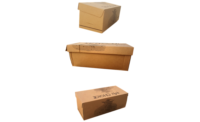This report presents historical data (2004, 2009 and 2014) plus forecasts for 2019 and 2024 by product and material type in value and volume terms, as well as by function and market in value terms. In addition, this study examines market environment factors, assesses the industry structure, analyzes company market share and profiles 44 competitors in the US industry.
Demand to increase 4.9% per annum through 2019
Demand for protective packaging in the US is forecast to rise 4.9 percent per year to $6.8 billion in 2019, driven primarily by the robust outlook for Internet shopping. Continued economic recovery following the 2007-2009 recession will also provide opportunities for protective packaging. These factors will contribute to the growth for cost-effective packaging used to limit the effects of shock, vibration, temperature abuse, and other damaging effects during shipping and handling.
Flexible protective packaging to remain as leading type
Flexible protective packaging will continue to be the leading protective packaging type through 2019, as flexible products are highly prized for their light weight, versatility, and aesthetic advantages over other materials such as plastic foams. The category is comprised of items such as protective mailers, which are the leading protective packaging product, and air pillows, which are expected to show the most rapid gains as users in every market looking for ways to eliminate excess package weight and cost often opt for air pillows over loose-fill alternatives. Also included in this category are bubble packaging products, paper fill, and dunnage bags.
Foam products are the second leading protective packaging type, with insulated shipping containers posting the fastest gains. These products are traditionally manufactured from expanded polystyrene or polyurethane foam and are used to protect temperature-sensitive products such as pharmaceuticals and food. Rigid protective packaging will comprise the smallest share of demand, although green initiatives will lead to above average gains for molded pulp and other niche products that are substituted for molded foam products as concerns regarding the environmental sustainability of foams continue to stifle demand.
Manufacturing markets to continue as top applications
Despite continued advances by the nonmanufacturing sector, protective packaging applications in manufacturing markets will continue to lead in value terms. Healthy growth in durable goods manufacturing for products such as appliances, motor vehicle parts, and industrial machinery will contribute to a high level of demand for protective packaging for these products and others that require cushioning and bracing during shipment. Demand for protective packaging intended for nondurable goods manufacturing will be driven by growing specialized handling requirements for temperature-sensitive pharmaceuticals, leading to a greater need for insulated shipping containers, products that can be manufactured from foam or a wide range of both flexible and rigid materials.
As the volume of products ordered online continues to grow, the number of shipments from both large retailers such as Amazon and small online marketplace contributors on sites such as Etsy will lead to rapid gains in demand for costeffective and visually appealing protective products for the Internet and catalog market. In addition, the burgeoning online grocery and meal delivery industry will drive demand for insulating material effective in controlling temperature but also environmentally friendly, as many consumers have concerns with the sustainability practices of these services.
Read the full report on reportlinker.com.
